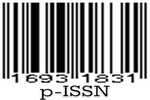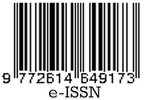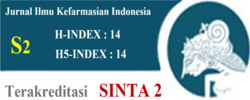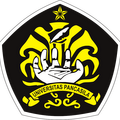Homology Modeling and Molecular Docking of Active Compounds from Bengkoang (Pachyrrhizus erosus) as Tyrosinase Inhibitor in Homo sapiens
Abstract
One mechanism of whitening agent is to inhibit the tyrosinase enzyme in melanogenesis process. However, since the human tyrosinase has not been determinated experimentally, therefore research on human tyrosinase can not be conducted. Homology modeling is one method that can be used to exhibit the three-dimensional structure of human tyrosinase. This model used to predict the interaction of bengkoang (Pachyrrhizus erosus) active compounds with the human tyrosinase enzyme by using a molecular docking approach (pose analysis). In addition, the strength of the bond between the ligand compounds and the site protein target can be predicted by analyzing the resulting score. Homology modeling was carried out using Amber99 method of software MOE 2009.10 and Bacillus megaterium (TyrBm) as a template. The model obtained was evaluated using Ramachandran plot analysis, z-score, and the plot energy ProSA. The best model used for molecular docking using the active site ligand, ALPHA PMI placement method, and affinity DG scoring of MOE 2009.10 software. The best model is the TyrHSM (MOE default alignment) with 96.7% residues are in allowed regions of the Ramachandran plot, has the least positive region, and has a z-score ratio> 1. The isolated compound 2-butoxy-2,5-bis (hydroxymethyl)-tetrahydrofurane-3,4-diol is predicted have the best affinity to human tyrosinase with a score -0.3598 kcal/mol.
References
2. Arbab AH, Eltahir MM. Review on skin whitening agents. Khartoum Pharm J. 2010.13(1):5-9
3. Mayer AM. Polyphenol oxidases in plants and fungi: Going places? A review. Phytochemistry. 2006.67 (21):2318–31.
4. Lewis EA, Tolman WB. Reactivity of dioxygen-copper systems. Chemical Reviews. 2004.104:1047-76.
5. Lukitaningsih E. The exploration of whitening and sun screening compounds in bengkoang roots (Pachyrhizus erosus) [Disertasi]. Jerman: Julius-Maximillians-Universität Würzburg; 2009.
6. Drenth J. Principles of protein X-ray crystallography. New York: Springer Science+Business Media LLC; 2007. 61.
7. Wiederstein M, Sippl MJ. ProSa-Web: Interactive Web service for the recognition of errors in the three-dimensional structures of protein. Nucleic Acids Res. 2007.35:407-10.
8. Dalton JAR, Jackson M. An evaluation of automated homology modelling methods at low target–template sequence similarity. Bioinformatics. 2007.23:1901-8.
9. Petsko GA, Ringe D. Protein structure and function: from sequence to consequence. London: New Science Press Ltd; 2004. 142.
10. Sendovski M, Kanteev M, Benyosef VB, Adir N, Fishman A. First structures of an active bacterial tyrosinase reveal copper plasticity. J Mol Biol. 2010. 405:227–37.
11. Sapre NS, Gupta S, Sapre N. Assessing ligand efficiencies using template-based molecular docking and tabu-clustering on tetrahydroimidazo-[4,5,1-jk][1,4]-benzodiazepin-2(1H)-one and-thione (TIBO) derivatives as HIV-1RT inhibitors. J Chem Sci. 2008.120(4):395–40
Licencing
All articles in Jurnal Ilmu Kefarmasian Indonesia are an open-access article, distributed under the terms of the Creative Commons Attribution-NonCommercial-ShareAlike 4.0 International License which permits unrestricted non-commercial used, distribution and reproduction in any medium.
This licence applies to Author(s) and Public Reader means that the users mays :
- SHARE:
copy and redistribute the article in any medium or format - ADAPT:
remix, transform, and build upon the article (eg.: to produce a new research work and, possibly, a new publication) - ALIKE:
If you remix, transform, or build upon the article, you must distribute your contributions under the same license as the original. - NO ADDITIONAL RESTRICTIONS:
You may not apply legal terms or technological measures that legally restrict others from doing anything the license permits.
It does however mean that when you use it you must:
- ATTRIBUTION: You must give appropriate credit to both the Author(s) and the journal, provide a link to the license, and indicate if changes were made. You may do so in any reasonable manner, but not in any way that suggests the licensor endorses you or your use.
You may not:
- NONCOMMERCIAL: You may not use the article for commercial purposes.
This work is licensed under a Creative Commons Attribution-NonCommercial-ShareAlike 4.0 International License.





 Tools
Tools





















